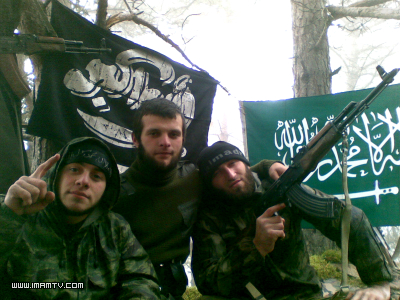
The Evolution of Salafism in the North Caucasus
Publication: Eurasia Daily Monitor Volume: 9 Issue: 157
By:

For the past twelve years of Russian armed containment of the ideology of the insurgents in the North Caucasus, the North Caucasian armed resistance has changed significantly. At first, only members of small radical Islamic jihadist groups participated in the local jamaats, which could not have had a significant impact on the general situation in the region. Today, however, the profile of the average militant is more complex than it was at the beginning of the second war in Chechnya in 1999.
The original Salafi amateurs have been replaced by a whole new layer of young Muslim scholars who received their education in Middle Eastern Arab countries and Albania (https://lezgi-yar.ru/news/ruslan_gereev_dagestanskuju_molodezh_privlekaet_kosovo/2012-04-29-749).
According to the Spiritual Board of Dagestani Muslims, over 1,500 people from Dagestan alone have gone abroad for Islamic studies during the past several years. This figure reflects just those people who were officially endorsed by the board, so the actual figure may be far higher (www.kommersant.ru/doc/13750/print). Before the start of hostilities in Syria, the estimated number of students of Islam from Chechnya in Syria topped 100 people and in some years reached 150. Two to three dozen Chechen students are studying in Saudi Arabia. Considerable numbers of Karachays, Circassians and Ingush are also studying Islam abroad, and even Muslims from North Ossetia studying overseas have ceased to be a rarity. The list of the countries where they are studying Islam has also expanded. Today, students of Islam from Russia are studying in Egypt, Saudi Arabia, Turkey, Tunisia, Jordan, Albania, the United Arab Emirates, Qatar, Pakistan, Malaysia and, until recently, Syria. Naturally, not all of those who study abroad should be seen as potential supporters of jihadism: students who have studied in Syria, Turkey and Malaysia often follow the more tolerant types of teachings. However, students studying in Egypt and Saudi Arabia normally renounce everything that is familiar for North Caucasian Muslims and demand an unequivocal break with “traditional” Islam in favor of Salafist teachings. So-called “traditional Islam” in the North Caucasus is a synthesis of Islam and pre-Islamic traditions and customary law in the region (https://institutabuhanifa.narod.ru/adatshariat.htm).
In the past, Chechens and Dagestanis were the chief ideologues of the armed resistance. This role has now been spread evenly among the other peoples of the region. Anzor Astemirov, an ethnic Kabardin and the chief ideologue of the insurgency, was one such example. Astemirov was killed on March 24, 2010. Said Buryatsky, an ethnic Russian from Siberia who converted to Islam, was another example. Buryatsky was killed on March 2, 2010 (www.ng.ru/scenario/2010-04-27/14_videopropaganda.html).
The ages of members of the armed resistance have also changed. There are only about two to three dozen people left of those who can be called the “founding fathers” of jihadism in the North Caucasus. A new generation of jihadists whose average age is 20 has replaced the jihadists aged 30-35 who were more common in the past (https://24news.ru/news/7333848n.html). The Russian authorities try to present the current generation of insurgents as “kids” who were misled by an alien ideology. The youth, however, are simply unequivocally anti-Russian. They blame Moscow for its policies in the region and regard the locals who collaborate with Moscow as enemies. So it should come as no surprise that in a survey taken in Dagestan last November, 12 percent of school children expressed support for the militants (www.portal21.ru/news/caucasus_reloading.php?ELEMENT_ID=1506).
Members of the armed resistance have also changed socially. Today, a member of the insurgency is not necessarily an impoverished rural male; indeed, city dwellers are increasingly involved in the insurgency. That is why more clashes take place within cities these days than in the past. Essentially, since there are more city residents in the insurgency, the law enforcement agencies were forced to shift the brunt of their operations from the forests and mountains to the cities (https://dagnovosti.ru/v-dagestane/281-kreml-i-salafity-kavkazskoe-raspute.html).
The insurgency’s spread in society is illustrated by the fact that the offspring of top officials have joined it. A vivid example of this trend emerged last week when we learned that the deputy head of Khasavyurt’s administration, Salimkhan Jamaldinov, was dismissed from his position, after his son, Iskhak, was discovered among a group of rebels who surrendered to the authorities on August 8. This is a prime example of today’s realities in Dagestan (www.rosbalt.ru/federal/2012/08/08/1020266.html). However, this is not the only case. Well-known athletes, people with Ph.D. degrees and former government officials have periodically been found among slain rebels (www.ekhokavkaza.com/content/article/24673322.html). This contradicts the government’s portrayal of the militants as backward, ignorant people who cannot be considered as a viable side in negotiations.
Another important change that has taken place in Dagestan in the past few years is that Salafi adherents now have options in the republic. Several years ago, there was no legal place for a Salafist to go, while now there is the organization Ahlu Sunna, which is essentially the political wing of the armed resistance. This is an entirely new development not only in Dagestan and the North Caucasus, but also for the Russian Federation as a whole. It allows a young follower of Salafist teachings to choose between joining the insurgency in the forests or cooperate with Ahlu Sunna (www.novayagazeta.ru/politics/53889.html).
Despite evidently high losses among members of the armed resistance in Dagestan, the intensity of fighting in the republic not only refuses to subside, but has even increased. Thus, it appears that the average rebel in Dagestan has gone through a considerable transformation. The changes signify that the confrontation between the armed resistance and the government has reached a qualitatively new stage, which renders the government’s fight against the Salafists utterly ineffective.




